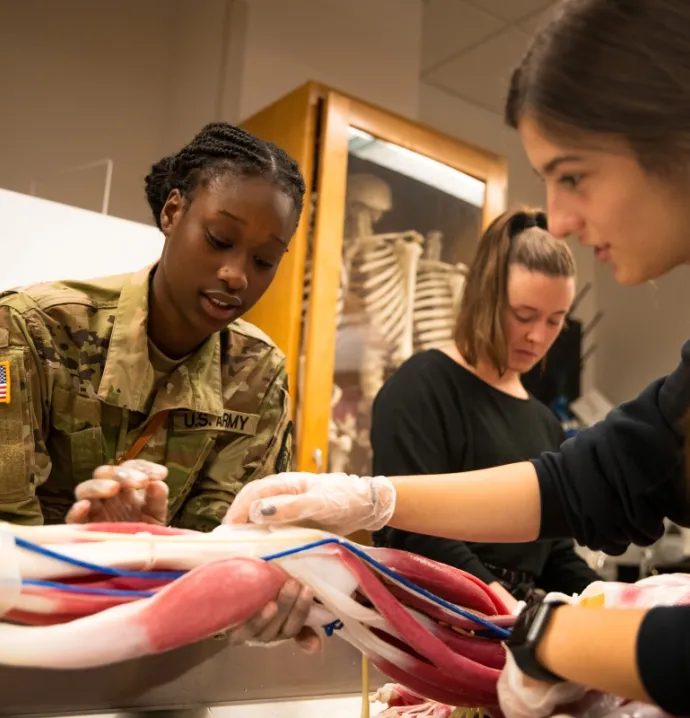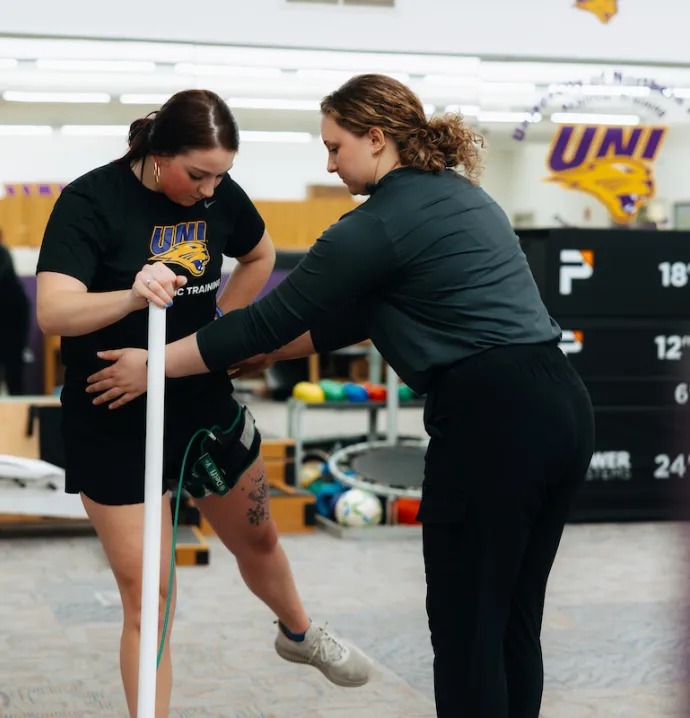Meet the alligators of UNI
Meet the alligators of UNI
A beast resides deep in the bowels of McCollum Science Hall.
This fearsome creature - with teeth that shred and claws that clatter - lurks in a corner of a laboratory behind a formidable gate marked with a sign that warns “enter at your own risk.”
And this menacing monster’s name is...Steve, an American alligator, who, contrary to his appearance - almost five feet long with black and yellow banding across his boney scales - is harmless.
“He’s not mean in any way. He's pretty well tamed,” said Jeff Tamplin, a biology professor and Steve’s official caretaker. “He's only ever really known this existence, and he's used to a lot of people coming around.”
Since arriving on campus in 2005 as an 8-inch baby, Steve has become the unofficial mascot of the biology department. Over the years, the crocodilian with a love of carp and baby pools has offered a joyful learning opportunity to countless UNI students, not to mention the elementary classes, alumni and Girl Scout and Boy Scouts troops who have visited him over the years.
“Steve is definitely the most popular non-human member of the department,” said Theresa Spradling, department head of biology. “Nearly every day, Jeff will have someone who stops in saying, ‘Hi, can I see the big alligator?’”
In short, Steve has made the exact impact former biology department head Barbara Hetrick was hoping for when she approached Tamplin with an unusual request over a decade ago.
An animal to make a splash
Hetrick saw an imbalance in the biology department. With a vibrant greenhouse filled with exotic plants on campus already engaging students, Hetrick wanted something similar from the zoology side of the field.
So, she approached the only man for the job - Tamplin, who arrived at UNI in 2001. Prior to that, he taught at Louisiana State University for 15 years, where he raised and released alligators his students found in flooded yards. He even worked as a reptile consultant on several movies, including the 1997 Robert Duvall drama “The Apostle,” where his job was to stand in swamp water just off camera to keep any snakes or alligators away from Duvall.
“So when Barbara came and said ‘can you get an animal to make a big splash?’ I said, ‘let’s get an alligator,’” Tamplin said.
Hetrick loved the idea, and Tamplin tracked down a licensed breeder in Ohio. A couple days and $125 later, Steve arrived.
“The gator was part of a major effort to make biology real for our students,” Hetrick said. “We simply did everything we could to capture and engage our students.”
It’s safe to say Hetrick’s mission was accomplished.
“People seem to remember Steve for a long time after they leave UNI, because visiting alumni often set aside a little time to come in and check on him,” Spradling said. “And it is a popular place to take our prospective students and families when they visit the department, because they can see the alligator, plus they can also see active, ongoing research projects playing out in the lab.”
At home in McCollum
Before going further, there are two points of order.
The first is that Steve is named after Steve Irwin, the late television personality and wildlife expert.
The second is that Tamplin actually doesn’t know if Steve is male or female, he simply uses the “he” pronoun because of the alligator’s name, which was bequeathed to him by three students around 2010.
The sex of an alligator is almost impossible to determine from the outside. They have a single opening that services their digestive, urinary and reproductive tracts, called the cloaca. The only way to determine Steve’s sex is by probing that opening.
“That’s probably not something he wants me to do or that I want to do,” Tamplin said.
Either way, male or female, Steve’s domain is a corner of room 72 in McCollum Science Hall. His home was hand-built by Tamplin and sits beneath several massive turtle shells and a tiger shark jaw hanging on the wall. A variety of turtles, snakes and lizards, as well as the equipment Tamplin uses for his turtle research, share the room with him.
By now, his presence is second nature for the students who work or study there. He can often be found soaking in his baby pool or basking on a platform beneath two 100-watt mercury vapor bulbs providing ultraviolet light, which is essential to reptile health. One particular spot he favors is a rock-filled patch of floor, which is heated by a steam tunnel running beneath it.
But when it’s feeding time, Steve gets more active. He starts to climb the walls of his enclosure, peeking his head over the top like any pet eagerly awaiting a meal. And when he chomps down on his morsel, he often just flops back to the floor, uncaring and satisfied.
Tamplin only feeds Steve enough to keep him healthy, so he doesn’t grow too fast. Tamplin is taking a similar approach with a younger alligator he acquired in 2014. This new alligator is named Wally, and, in fact, is Steve’s sibling. Wally lives in a tank just down the hallway, but the two have never met.
Yet while Steve came to the biology department through an intentional purchase, Wally arrived in a slightly different way.
“A potentially illegal and dangerous reptile”
Tamplin’s reptile-whispering reputation extends well beyond campus. Which is why one night he was awakened by a 2 a.m. phone call. Waterloo police needed help with a “potentially illegal and dangerous reptile” that an unsuspecting postal worker had come across, he said.
A squad car was in his driveway.
At the post office, Tamplin found a box from the very same Ohio-based breeder that produced Steve. A tiny, cold alligator was inside, too cold to move. “I just grabbed it and pulled it up and everybody jumped back shocked and somewhat scared of it,” he said.
A recently passed Iowa law made it illegal for a private citizen to possess the creature and the police would have to euthanize it unless Tamplin took it.
And so it was that Wally found himself at home in a 90-gallon tank along the basement hallway of McCollum - the very same enclosure that Steve occupied before he outgrew it.
Today, the pair of alligators offer students and visitors a snapshot of exotic life as well as a chance to learn how a once-endangered species is now thriving.
“We Midwesterners don’t get the opportunity to see these iconic creatures up close very often,” Spradling said. “Because crocodilians represent a bit of prehistoric life— predating the rise of mammals and surviving the Cretaceous mass extinction--they can inspire the imagination.
“We can share a conservation success story with people that helps bring a greater understanding about the importance of our actions and our policies protecting nature.”
The alligators have also endeared themselves to students like science education major Katie Staff, who likes feeding them.
“Crocodilians are much more intelligent than the average reptile, and they recognize the people who they see often. They know who feeds them. I could always get them to come to the front of their enclosures,” Staff said. “I really enjoyed showing both alligators to visitors, and they were certainly a draw for people.”
And with a lifespan that can eclipse 50 years, Steve and Wally aren’t going anywhere. And that’s fine with Tamplin.
“I love this animal. It’s basically one of my pets. I don’t want to get rid of it,” he said. “The longer it can stay in here and be a part of the university and have the kids that love to see it come in here, the better.”







